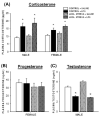Sex differences in the effects of adolescent stress on adult brain inflammatory markers in rats
- PMID: 23348027
- PMCID: PMC3641183
- DOI: 10.1016/j.bbi.2013.01.075
Sex differences in the effects of adolescent stress on adult brain inflammatory markers in rats
Abstract
Both basic and clinical research indicates that females are more susceptible to stress-related affective disorders than males. One of the mechanisms by which stress induces depression is via inflammatory signaling in the brain. Stress during adolescence, in particular, can also disrupt the activation and continued development of both the hypothalamic-pituitary-adrenal (HPA) and -gonadal (HPG) axes, both of which modulate inflammatory pathways and brain regions involved in affective behavior. Therefore, we tested the hypothesis that adolescent stress differentially alters brain inflammatory mechanisms associated with affective-like behavior into adulthood based on sex. Male and female Wistar rats underwent mixed-modality stress during adolescence (PND 37-48) and were challenged with lipopolysaccharide (LPS; 250μg/kg, i.p.) or saline 4.5weeks later (in adulthood). Hippocampal inflammatory marker gene expression and circulating HPA and HPG axes hormone concentrations were then determined. Despite previous studies indicating that adolescent stress induces affective-like behaviors in female rats only, this study demonstrated that adolescent stress increased hippocampal inflammatory responses to LPS in males only, suggesting that differences in neuroinflammatory signaling do not drive the divergent affective-like behaviors. The sex differences in inflammatory markers were not associated with differences in corticosterone. In females that experienced adolescent stress, LPS increased circulating estradiol. Estradiol positively correlated with hippocampal microglial gene expression in control female rats, whereas adolescent stress negated this relationship. Thus, estradiol in females may potentially protect against stress-induced increases in neuroinflammation.
Copyright © 2013 Elsevier Inc. All rights reserved.
Figures



References
-
- Angold A, Costello EJ, Worthman CM. Puberty and depression: the roles of age, pubertal status and pubertal timing. Psychol. Med. 1998;28:51–61. - PubMed
-
- Audet MC, Jacobson-Pick S, Wann BP, Anisman H. Social defeat promotes specific cytokine variations within the prefrontal cortex upon subsequent aggressive or endotoxin challenges. Brain. Behav. Immun. 2011;25:1197–1205. - PubMed
-
- Bebbington P, Dunn G, Jenkins R, Lewis G, Brugha T, Farrell M, Meltzer H. The influence of age and sex on the prevalence of depressive conditions: report from the National Survey of Psychiatric Morbidity. Int. Rev. Psychiatry. 2003;15:74–83. - PubMed
Publication types
MeSH terms
Substances
Grants and funding
LinkOut - more resources
Full Text Sources
Other Literature Sources
Medical

